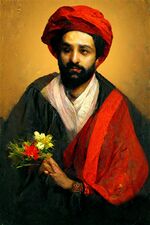Zahrah at-Tahirah
Zahrah at-Tahirah the First Martyress | |
|---|---|
 | |
| Born | 1011 Eshek Qoriksı |
| Died | 1050 Jasil Salabalar |
| Venerated in | Esoteric Shi'ism |
| Major shrine | Shrine of Zahrah at-Tahirah |
| Feast | Day of Silencing |
| Part of a series on | |||||
| Esoteric Shi'ism | |||||
|---|---|---|---|---|---|
 | |||||
| The Seven Figures | |||||
|
|||||
| The Seven Principles | |||||
|
|||||
| Beliefs and practices | |||||
| Place of worship | |||||
|
|||||
| Holy days | |||||
|
|||||
| Texts | |||||
| Governance | |||||
Zahrah at-Tahirah (Riysan: زهره الطاهره, "Zahrah the Pure One"; c. 1011-1050 CE), also called Shahidah al-Awwal (The First Martyress) and Zahrah of Eshek Qoriksı, was one of the first believers of Esoteric Shi'ism and the first woman to be martyred for her faith in the religion. She was the daughter of a Zahiri Shia theologian Shaykh Mubarak, who disowned her after learning of his daughter's conversion. In Esoteric Shi'ism, she is considered as one of the Five Martyrs and Seven Figures, thus occupying a revered station in the religion. Al-Sayyid al-Mu'alim, the founder and central figure of Esoteric Shi'ism, referred to her as "she, whose praises the birds of the earth sing, for whose martyrdom the waves of the seas surge in lamentation". A successful merchant in her own right, she financially supported Al-Sayyid al-Mu'alim's ministry and used her resources to protect the nascent Esoteric Shia community from the harassments of Zahiri Shias in Jartasti, modern-day Maqtajer.
Born in Eshek Qoriksı, modern-day Maqtajer, in YEAR, Zahrah was the daughter of a prominent Zahiri Shia theologian. Her father gave her a private education in the arts of writing and the more complex points of religion. In her teenage years, she composed many poems praising the Hidden Imam, for which she gained renown amongst the Zahiri Shia community of Eshek Qoriksı. She became acquainted with the teachings of Al-Sayyid al-Mu'alim through a group of early Esoteric Shia believers in her hometown, when Al-Sayyid al-Mu'alim was still ministering in Jasil Salabalar. After attending a number of Esoteric Shia gatherings, she became convinced of Esoteric Shi'ism and subsequently declared her faith. After her conversion, and subsequent disowning by her family, she soon became a respected figure in the Esoteric Shia community for her active role in supporting the community and in disseminating the religion's teachings to the Zahiri Shias. She was outspoken in her criticism of the Zahiri Shia clergy, which earned her the scorn of the Zahiri Shia community. As the number of Esoteric Shia believers grew in Eshek Qoriksı, she and the Esoteric Shia community were exiled from their hometown, and they travelled to Jasil Salabalar to join Al-Sayyid al-Mu'alim and his followers.
Zahrah was best known for her high-profile debates with theologians opposed to Esoteric Shi'ism. Her debate with Shaykh Tayr, leader of the Friday Prayers in Jasil Salabalari Shia community, resulted in her meeting her fate; she was strangled to death by Shaykh Tayr's supporters as she left the place of debate. Her death triggered an Esoteric Shia uprising in Jasil Salabalar, which was put down when Al-Sayyid al-Mu'alim commanded them to stop and exercise restraints and patience. It was soon after the death of Zahrah that Al-Sayyid al-Mu'alim began telling his followers to migrate to Tanjudan, in modern-day Hindia Belanda, as the persecution of the Esoteric Shias of NameOfSoutheastRegionOfMaqtajer grew more severe.
Her life, influence and eventual martyrdom turned Zahrah into a revered saint in Esoteric Shi'ism. Her memory is remembered by Esoteric Shias on the Day of Silencing every year; prayers of visitation are recited in her commemoration and alms are distributed in her name. Zahrah was initially buried in Jasil Salabalar, but her remains were brought to Tanjudan by Esoteric Shia emigres. In 1703, her remains were transferred to Java, Hindia Belanda, and buried on the eastern slopes of Mount Ilias, on top of whose grave is a shrine built by the 25th Auxiliary Imam, Sayyid Mudaffi.